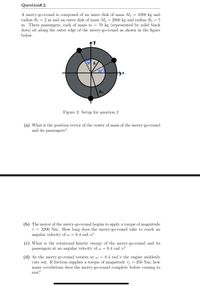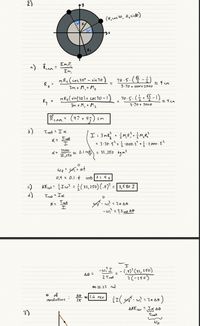
College Physics
11th Edition
ISBN: 9781305952300
Author: Raymond A. Serway, Chris Vuille
Publisher: Cengage Learning
expand_more
expand_more
format_list_bulleted
Question
R2 please answer all problems and also write out all steps and reasoning. The second image shows the correct answers.

Transcribed Image Text:QuestionR.2.
A merry-go-round is composed of an inner disk of mass M1
radius R1 = 2 m and an outer disk of mass M2
m. Three passengers, each of mass m
1000 kg and
2000 kg and radius R2 = 5
70 kg (represented by solid black
dots) sit along the outer edge of the merry-go-round as shown in the figure
below.
Rz
Figure 2: Setup for question 2
(a) What is the position vector of the center of mass of the merry-go-round
and its passengers?
(b) The motor of the merry-go-round begins to apply a torque of magnitude
T = 3200 Nm. How long does the merry-go-round take to reach an
angular velocity of w =
0.4 rad/s?
(c) What is the rotational kinetic energy of the merry-go-round and its
passengers at an angular velocity of w = 0.4 rad/s?
(d) As the merry-go-round rotates at w =
cuts out. If friction supplies a torque of magnitude Tf
many revolutions does the merry-go-round complete before coming to
0.4 rad/s the engine suddenly
250 Nm, how
rest?

Transcribed Image Text:2)
(R;cos 30, Resinso)
a)
M Rq (cos 30° - sia 30)
3M+ M,+ M2
70.5.( -)
2
%3D
a 4 cm
%3D
3.70 + 1000t2000
70.5.(술
목-1)
MRq( sint30\+ cos 30 -1
3m + M, + Mz
Ry
z 4 cm
3.70 + 3000
Reom= (4?+4;)
Inet =
%3D
d = [net
= 3-70.5"41000. 2° +
2 000. 5?
3200
* 0.1 raya
= 32,250 kgm?
32,250
0.4 프 0.1.+ |+: 4s
c)
KErot = Iw? =(32,250) (.4) = | 2,5 80 J
Tnet= Ix
Tret
- w; = 2Tnet 0e
I.
-wI-(.4)'(32, 150)
2(-250)
2 Tnet
e 10.32 rad
# of
revolutions
띠1.6 reV
• W.
AKEror
סA אL
%3D
3)
Tnet
We
Expert Solution
This question has been solved!
Explore an expertly crafted, step-by-step solution for a thorough understanding of key concepts.
Step by stepSolved in 5 steps with 4 images

Knowledge Booster
Learn more about
Need a deep-dive on the concept behind this application? Look no further. Learn more about this topic, physics and related others by exploring similar questions and additional content below.Similar questions
- Please see attached image. I do not understand how to start this problem. Please explain in as much detail as possible.arrow_forwardPlease help with parts g and h Two velocity vectors are defined as follows: v1 = 40.0 m/s, 50.0 degrees cw from the +x axis v2 = 30.0 m/s, 75.0degrees cw from the -y axis d) Calculate the x- and y-components of v2. Write the vector v2 in terms of its components using unit vector notation. e) Calculate the x- and y-components of the change in velocity defined as Δv= v2-v1. Write the vector Δv in terms of its components using unit vector notation. f) Sketch the vector Δv on an x-y grid. Define a relevant angle symbolically whose numerical value you will calculate in the next part. g) Calculate the magnitude and direction of the vector Δv. h) Finally, write the vector Δv in terms of its magnitude and direction.arrow_forwardYou first walk 10 meters at an angle of 30 degrees East of North. Then,you walk 15 meters at an angle of 45 degrees South of East. Assume that East is +x and North is+y, and assume you started at the origin (0,0). A. Make a graph with x- and y-axes and draw your path on that graph (to scale, or at least asclose as you can get). Start the first vector at the origin, and the second vector at the tip ofthe first vector. Then, draw the resultant vector (their sum). B. Break each part of the walk into their x- and y-components and then sum them to get thex- and y-components of the resultant vector. Make sure to include units and unit vectors. C. What is your displacement from where you originally started? D. If the whole walk took 40 seconds, then what was your average velocityarrow_forward
- I need magnitude and direction of D of the displacement from start to finish explain please.arrow_forwardYou decide to walk from your home to your friend's house. He lives 164 meters away from you at an angle 59° South of East. What is the eastern component of your displacement? m What is the southern component of your displacement? marrow_forward
arrow_back_ios
arrow_forward_ios
Recommended textbooks for you
 College PhysicsPhysicsISBN:9781305952300Author:Raymond A. Serway, Chris VuillePublisher:Cengage Learning
College PhysicsPhysicsISBN:9781305952300Author:Raymond A. Serway, Chris VuillePublisher:Cengage Learning University Physics (14th Edition)PhysicsISBN:9780133969290Author:Hugh D. Young, Roger A. FreedmanPublisher:PEARSON
University Physics (14th Edition)PhysicsISBN:9780133969290Author:Hugh D. Young, Roger A. FreedmanPublisher:PEARSON Introduction To Quantum MechanicsPhysicsISBN:9781107189638Author:Griffiths, David J., Schroeter, Darrell F.Publisher:Cambridge University Press
Introduction To Quantum MechanicsPhysicsISBN:9781107189638Author:Griffiths, David J., Schroeter, Darrell F.Publisher:Cambridge University Press Physics for Scientists and EngineersPhysicsISBN:9781337553278Author:Raymond A. Serway, John W. JewettPublisher:Cengage Learning
Physics for Scientists and EngineersPhysicsISBN:9781337553278Author:Raymond A. Serway, John W. JewettPublisher:Cengage Learning Lecture- Tutorials for Introductory AstronomyPhysicsISBN:9780321820464Author:Edward E. Prather, Tim P. Slater, Jeff P. Adams, Gina BrissendenPublisher:Addison-Wesley
Lecture- Tutorials for Introductory AstronomyPhysicsISBN:9780321820464Author:Edward E. Prather, Tim P. Slater, Jeff P. Adams, Gina BrissendenPublisher:Addison-Wesley College Physics: A Strategic Approach (4th Editio...PhysicsISBN:9780134609034Author:Randall D. Knight (Professor Emeritus), Brian Jones, Stuart FieldPublisher:PEARSON
College Physics: A Strategic Approach (4th Editio...PhysicsISBN:9780134609034Author:Randall D. Knight (Professor Emeritus), Brian Jones, Stuart FieldPublisher:PEARSON

College Physics
Physics
ISBN:9781305952300
Author:Raymond A. Serway, Chris Vuille
Publisher:Cengage Learning

University Physics (14th Edition)
Physics
ISBN:9780133969290
Author:Hugh D. Young, Roger A. Freedman
Publisher:PEARSON

Introduction To Quantum Mechanics
Physics
ISBN:9781107189638
Author:Griffiths, David J., Schroeter, Darrell F.
Publisher:Cambridge University Press

Physics for Scientists and Engineers
Physics
ISBN:9781337553278
Author:Raymond A. Serway, John W. Jewett
Publisher:Cengage Learning

Lecture- Tutorials for Introductory Astronomy
Physics
ISBN:9780321820464
Author:Edward E. Prather, Tim P. Slater, Jeff P. Adams, Gina Brissenden
Publisher:Addison-Wesley

College Physics: A Strategic Approach (4th Editio...
Physics
ISBN:9780134609034
Author:Randall D. Knight (Professor Emeritus), Brian Jones, Stuart Field
Publisher:PEARSON